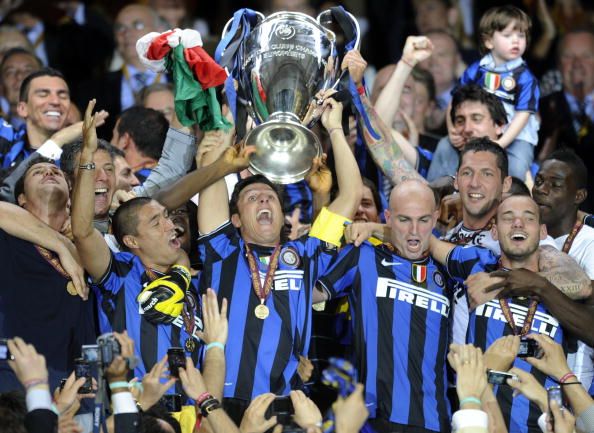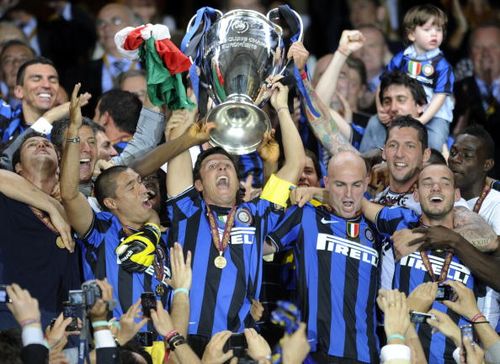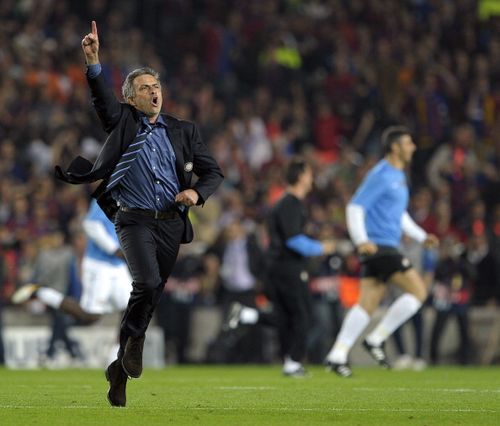
Inter Milan: The class of 2010
Given the current standings in Serie A, FC Internazionale is lagging behind in ninth place, separated by a massive 15 points from its cross city rivals AC Milan. But it was not long back when the Inter side stunned the entire footballing world by lifting their third Champions League trophy en route to completing a treble. In their journey to the Champions League crown, they defeated the likes of Chelsea, a star studded Barcelona and Bayern Munich. Such was the dominance of the Inter side that it reached a level of stardom, but to their dismay, that stardom was short lived and currently they are struggling even to get a berth in Europe.
Inter’s golden era began soon after the burst of Calciopoli scandal in 2006 that saw the Scudetto winners, Juventus, being relegated to Serie B and Inter eventually being crowned champions. With lack of overall competition in Serie A, Inter thereafter found it relatively easy to deal with rivals domestically. Under their manager, Roberto Mancini, Inter kept on tasting domestic success by lifting the Scudetto three times consecutively from 2005-06 to 2007-08 and the Coppa Italia in 2004-05 and 2005-06. It was in Europe where it really struggled to make its presence felt. And it was for the same reason, despite being dominant in the domestic arena, that Mancini had to part his ways with the club. This ultimately led to the appointment of Jose Mourinho as the new Inter manager.

After Mourinho’s appointment as the new Inter manager, he started making his own team by signing players like Quaresma, Mancini and Muntari, and promoting Balotelli and Santon to the first team. In his first, even though he managed to lift the Scudetto (4th consecutive time for Inter), his team was bowed out of both the Coppa Italia and UEFA Champions League. His first season at Inter was thus labelled as a failure by many fans due to the team’s inability to do well in Europe. But Moratti restored his faith in the Portuguese manager and also provided him with a decent transfer budget.
During the 2009-10 transfer window, Mourinho made some calculated signings after identifying the various areas that needed reinforcements. He signed the underrated striker Diego Milito, Real Madrid outcast Wesley Sneijder, Thiago Motta, and exchanged the mercurial Zlatan Ibrahimovic with Samuel Eto’o in a player-plus-cash deal with Barcelona. This was the beginning of a new- look Inter side. However, initially Mourinho’s men struggled to make a mark, but soon they reached their peak in their domestic performances. As far as their European performances were concerned, they were sluggish as they lost 2-0 against Barcelona at Camp Nou and could only draw their home game against the same opposition. However, with wins against Dynamo Kyiv and Ruben Kazan, they reached the knock-out round of the UEFA Champions League.
It was in the knock-out stage where Mourinho’s tactical brilliance, coupled up with disciplined performances from the players, was evident. In their Round of 16 game, they were pitted against Chelsea. In the first leg at San Siro, starting with a diamond formation with Diego Milito and Eto’o upfront with Sneijder behind them with creative responsibilities, it was Diego Milito who opened the scoring. But soon the joyous mood of the San Siro crowd turned to despair as Kalou equalized and gave the visitors an all important away goal which could have proved decisive. However, it was Cambiasso’s strike that restored the advantage for the home side to allow them some breathing space and a hope to avoid a fourth consecutive exit from the knock-out stage. In the return leg at Stamford Bridge, it was a happy home-coming for Mourinho as his side trounced the home side by a solitary Eto’o goal. Again, a lot of credit for this victory should go to Mourinho’s tactical brilliance, as he started with a 4-2-3-1 formation to exploit Chelsea’s weakness in wide areas, and was helped by a defensive master class performance led by Lucio and Samuel. This win put Inter in the quarter finals of the Champions League for the first time in four years.
In their quarter final clash against CSKA Moscow, it was relatively easy for them as they could win both the legs with goals from Milito and Sneijder that ultimately put them in the semi finals against Barcelona. It was this clash that established the genius of Mourinho and proved that Inter’s run in the Champions League was not a matter of fluke but ridden by a series of brilliant performances built from a solid backline.
Inter met Barcelona in the semifinal with San Siro hosting the first leg. Already having been defeated by the Catalan powerhouse in the group stage, it was a tough test for the resurgent Nerazzurri. Starting with a similar formation of 4-2-3-1, with Milito upfront, the dominant Tiki-Taka philosophy was up against Catenaccio. And within the first 20 minutes of play, Barcelona took the lead through Pedro and it seemed to everybody that Inter were about to head towards another Champions League exit. But Mourinho’s men had something else in their mind. Thinking of blowing away Inter at their own backyard, the Barcelona midfielders hardly contributed towards their defensive duties and that left huge amount of empty spaces behind their midfield, thereby allowing the Inter attackers to exploit it. Inter restored parity through a well taken goal by Wesley Sneijder. Inter slowly started dominating the course of the play post half time. There was enough fluidity in their attack and Eto’o, Milito, Pandev and Sneijder interchanged seamlessly, thereby making life for Barcelona defenders miserable. Inter soon took the lead through Maicon and Milito doubled their advantage. Barcelona tried hard to get another away goal but it was the tactical discipline of Inter’s backline comprising of Zanetti, Maicon, Samuel and Lucio, that didn’t allow the away team to gain any advantage. The tie ended in a 3-1 victory for the home side and prepared a battleground for one pf the most exciting clashes ever in Champions League history in the form of a return leg at Camp Nou.

The return leg at Camp Nou witnessed one of the best tactical master-class displays by Jose Mourinho and his team. This was one of the games that proved that even defending can look classy. Riding on a 2-goal advantage, Mourinho fielded a defensive side by deploying Chivu on the left wing instead of Pandev. Everything was going as planned but the red card to Thiago Motta (courtesy Sergio Busquets‘ theatrics) gave an on-field numerical advantage to the hosts. Mourinho had to change his formation by letting Chivu occupy a more central position. Cambiasso and Zanetti were given the responsibility of cutting off the supplies from Xavi to Messi, which they both did with much aplomb. Samuel, Lucio and Maicon were up to their tasks of neutralizing Pedro and Iniesta. Ultimately, the idea of going for positional play rather than possessional play paid in favour of the visitors as they won the tie 3-2 on aggregate. There was a beauty in the defensive display by the Inter side that might have lost the leg by a solitary goal but won the hearts of viewers. The victory put them in the finals and gave them a hope of clinching the trophy after a gap of 45 years.
Before the UEFA Champions League finals, Inter captured their fifth consecutive Scudetto and doubled their success story with a victory over AS Roma in the Coppa Italia through a Diego Milito strike. Their only focus was to lift the Champions League crown to complete a historic treble. It was against Bayern Munich at Madrid, where once again Inter showed an amazing combination of attack and defence and trounced their opponents through a Milito brace. That victory completed a historic treble for Inter Milan.
Their success story can be attributed to a number of parameters. It was a combination of Jose Mourinho’s tactics, Julio Cesar’s commanding presence inside the six yard box coupled up with some brilliant saves, solidarity at the back with some effective positional awareness and last ditch tackles and blocks by the defense comprising of Maicon, Zanetti, Lucio and Samuel. Poacher-like finishing abilities of Milito and Eto’o and the creative brilliance of Sneijder with effective midfield control by players like Cambiasso and Motta also contributed to their success. Such was the class of Inter Milan team of 2010.
After Mourinho’s departure, things began to change, with injuries to key players, loss of form and ultimately departure of some players led to a downfall of a great team that had the potential to rule the world.